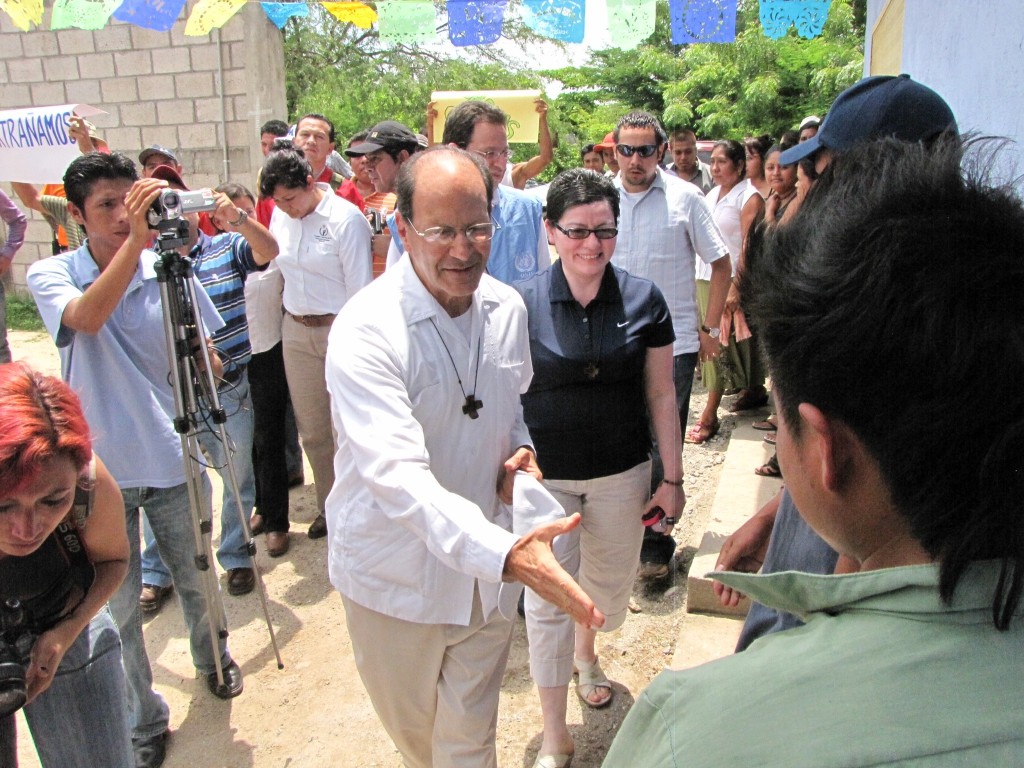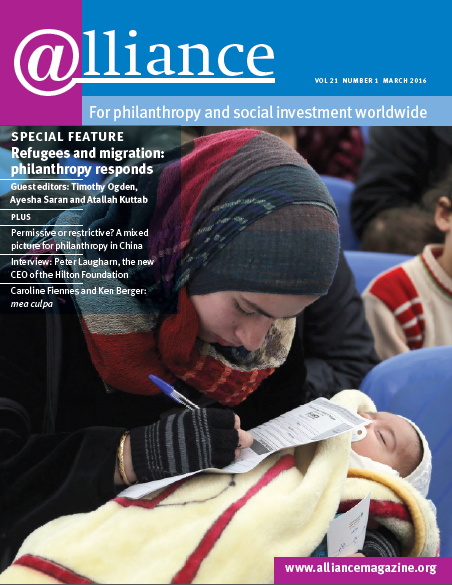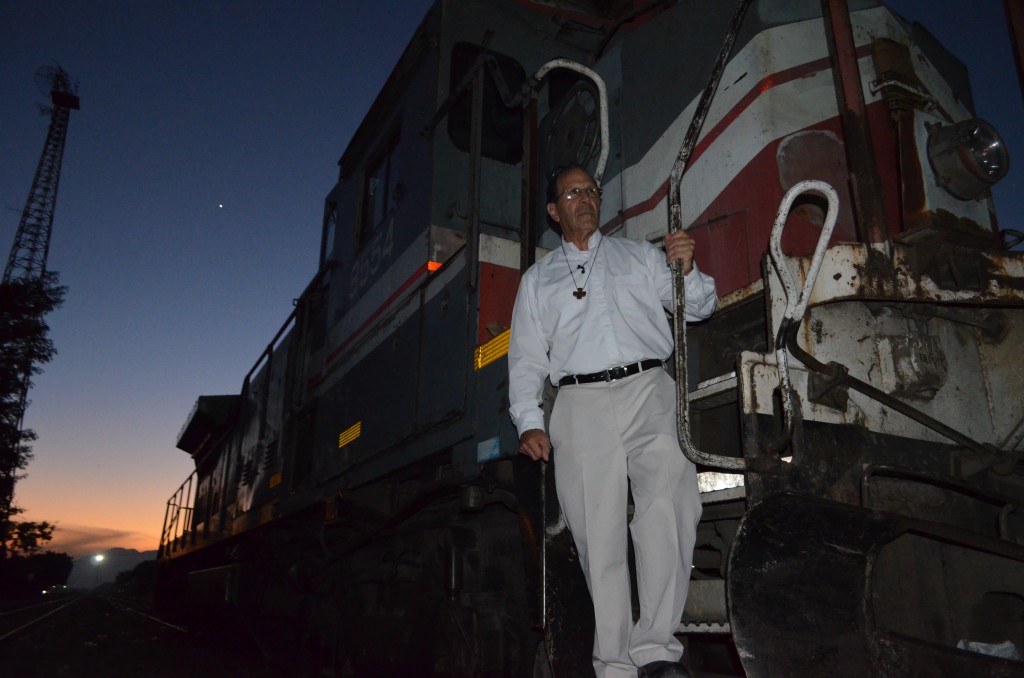‘The situation faced by foundations and migrant rights organizations responding to the migration crisis is overwhelming,’ says Lourdes Sanz of the Mexican Center for Philanthropy (Cemefi), ‘yet international non-profits, regional grassroots organizations, migrant movements, networks and church-run shelters are involved in everything from devising transnational solutions to looking for thousands of migrants who are missing or feared dead.’
Thousands are fleeing gang warfare in El Salvador, Honduras and Guatemala, a region known as the Northern Triangle, at a time when major US foundations involved in the migration effort are restructuring or pulling back.
Migration from Mexico and Central America to the US is nothing new, but now migrants are not just looking for the American Dream but for refuge from an epidemic of violence in their countries of origin. Honduras and El Salvador, two of the countries with the most migrants, have two of the highest homicide rates in the world. But the journey north is full of obstacles. Passing through Mexico – as an estimated 400,000 do each year – they face grave human rights violations at the hands of criminal gangs.
Migrants travel through some of the most dangerous, cartel-ridden regions in order to get to the US. Mexico’s unprecedented level of violence, due to its decade-long drug war, has claimed the lives of more than 100,000 civilians according to Mexico’s National Institute for Statistics, Geography and Information (INEGI).
One of the root causes of the migration crisis, says Kim Krasevac, who runs the Ford Foundation’s migration programme in Mexico and Central America, is ‘a very restrictive immigration policy from the US towards impoverished Mexicans and Central Americans … Since these migrants can’t get authorized entry into the US, they are forced into the arms of human smugglers, and over the years, the human smuggling business has increasingly been taken over by organized criminal organizations’.
Deportation Nation
Mexico is becoming a ‘Deportation Nation’ says Marco Castillo, director of the Popular Assembly of Migrant Families (APOFAM). As a result of the 2014 ‘surge’ of unaccompanied Central American child migrants fleeing to the US, Mexico introduced its Southern Border Plan, by which it is now deporting more Central Americans than the US, according to the Washington Office on Latin America (WOLA).
‘The authorities here are making it so hard for migrants that they are seeking alternative routes,’ adds Castillo. ‘Many are not even jumping on a train known as La Bestia or The Beast (so named because it amputates migrants’ limbs if they happen to fall under its wheels) because it’s been ordered to go faster than ever, forcing the migrants to look for alternative routes, where there are no shelters, and they fall into the hands of organized crime.’
The migrants have been easy prey for Mexico’s drug cartels. The Mesoamerican Migrant Movement, an NGO that organizes yearly caravans of Central American mothers looking for their missing children and relatives, estimates that up to 20,000 migrants go missing every year in Mexico. Six out of every 10 Central American women making the trip north are raped or subjected to sexual harassment, according to Amnesty International.
‘Six out of every 10 Central American women making the trip north are raped or subjected to sexual harassment, according to Amnesty International.’
Systematic murder
One of the people helping migrants is Father Alejandro Solalinde, a 70-year-old priest and human rights activist who runs a shelter on the migrant route in Ixtepec in Mexico’s southern state of Oaxaca. ‘What is happening to the migrants is systematic murder,’ says Solalinde. ‘The abuse they face is only possible because the criminal gangs are in cahoots with the local, state and federal police, as well as with Mexico’s National Institute of Immigration (INM).’
Father Solalinde and other shelters like his have received numerous testimonies from migrants who have suffered theft, extortion and sexual abuse by agents of the INM. The Ford Foundation funded a study that looked at accountability within the INM, and, according to Krasevac, ‘the INM is one of the government bodies that most often violates the human rights of migrants’.

Father Alejandro Solalinde returns to his shelter in Oaxaca after seeking safety outside the country in 2012. Credit: David Agren.
The local philanthropic response
Since setting up the Hermanos en el Camino (Brothers on the Road) in 2007, Solalinde’s shelter has given refuge (as well as food, medical, legal and psychological assistance) to some 20,000 migrants per year. He receives no regular funding from the Mexican Catholic Church or foundations but relies on individual philanthropists and the generosity of locals who donate rice, beans and other necessities. He has had death threats and is regularly intimidated. At present he has four bodyguards. Given that in the last three years, 11 priests have been killed at the hands of organized crime in Mexico, he is right to be concerned. ‘I know my guards are only a deterrent, I know if they want to kill me, they will.’
‘Solalinde has had death threats and is regularly intimidated. At present he has four bodyguards.’
The involvement of institutional philanthropy
Despite high concentrations of wealth, Mexico has few endowed foundations, so it is often US foundations like Ford, MacArthur and Open Society Foundations that lead philanthropic efforts to help migrants in Mexico and Central America. The scope of their work in Mexico is as complex as it is ambitious. Sharon Bissell, director of the MacArthur Foundation Mexico office, describes its work, which has supported over 25 organizations in Mexico since it began in 2006, as ‘looking at migration from Central America to Mexico, as well as transit migration through Mexico to the US, Mexican migration to the US as well as return migration and deportation from the US’.
Similarly, the Ford Foundation’s migration programme in Mexico and Central America for the past eight years has worked with over 70 regional organizations, focusing on the human rights violations of migrants. ‘One of our achievements is getting organizations to work together in a more strategic way, otherwise people get overwhelmed by the symptoms and it’s hard to look at the causes,’ adds Krasevac.
‘One of our achievements is getting organizations to work together in a more strategic way, otherwise people get overwhelmed by the symptoms and it’s hard to look at the causes.’
Although the larger amounts of funding come from outside Mexico, one Mexican foundation creating lasting impact is Fundación BBVA Bancomer, which has several programmes supporting the families of migrants who stay behind in Mexico. When the father, or head of household, migrates to the US looking for employment, children and teenagers left behind are often obliged to leave school to supplement the household income. In response, BBVA launched ‘scholarships for the integration of those who stay behind’.
Collaborative action
There has also been action by other foundations. One example is the founding of the Central America and Mexico Migration Alliance (CAMMINA), formed as an urgent response to the massacres of migrants at San Fernando and Cadereyta in northern Mexico in 2010-11. It was launched as a joint fund by the Avina, Ford and Open Society Foundations to develop a collaborative strategy on migration, pooling funds and know-how.
‘We knew things were bad,’ says Edith Zavala, director of programmes at CAMMINA, ‘but after the first massacre of 72 migrants and the discovery of 193 bodies in clandestine graves in San Fernando, followed by the Cadereyta massacre when 49 torsos, also believed to be migrants, were found with their heads, feet and hands cut off, there was an urgent sense that human rights and migration organizations needed to respond differently, the problem transcended borders.’
When news of the massacres reached families in Central America, there was no access to justice for the victims or their families. ‘The way the process was handled was terrible from the beginning,’ says Zavala. ‘The families were told they would have to pay for the transfer of the body and the funeral costs. Many didn’t believe the veracity of the identifications being made, as some had been sent the wrong bodies.’
‘The families were told they would have to pay for the transfer of the body and the funeral costs. Many didn’t believe the veracity of the identifications being made, as some had been sent the wrong bodies.’
It was after devastating experiences like these that various organizations from Guatemala, Honduras and El Salvador, along with CAMMINA, got together to create a system that victims’ families could trust. As a result, they set up a forensic commission working with the Argentine Team of Forensic Anthropology (EEAF). So far 33 bodies have been identified and a protocol to notify families about the massacres has been implemented.
The MacArthur Foundation has also been active in funding forensic work and has supported the work of the EAAF to create a regional framework to locate missing migrants. It has also supported an initiative spearheaded by the Foundation for Justice that allows victims’ families to file a criminal complaint – whether it be related to kidnapping, homicide, disappearance, or any other crime committed against a migrant in Mexico.
Children on the run
When the child migrant crisis broke out in 2014, when up to 67,000 unaccompanied minors arrived in the US, CAMMINA was ideally placed to respond as it had already carried out a detailed mapping of the organizations involved in child migration. This information was crucial to represent the critical situation of children in Central America to lawmakers in the US, and what a mass deportation of children to situations of extreme violence would mean.
Similarly, the MacArthur Foundation funded Children on the Run, a UNHCR study on unaccompanied minors that included the testimonies of over 400 children, highlighting the need for international protection, not deportation.
Though the situation remains dire, Krasevac of the Ford Foundation says there have been some advances by civil society: ‘Our joint efforts have added to changes in policies and creation of a learning community of people on migration policy who communicate constantly.’
One organization that has benefited from both the Ford and MacArthur Foundations is the Institute for Women in Migration (IMUMI), set up by Gretchen Kuhner, an American living in Mexico, as a response to the deportations. ‘Because of the deportations, we came across horrible family separations, parental rights were being lost, kids were being adopted in the US while their parents were sent back to their countries of origin.’ Kuhner describes her legal clinic as ‘the intersection between Mexican family law and US family law – making a horrible situation less horrible’.
‘Because of the deportations, we came across horrible family separations, parental rights were being lost, kids were being adopted in the US while their parents were sent back to their countries of origin.’
Institutional philanthropy pulling back
But the work of the IMUMI, which receives up to 70 per cent of its funding from the Ford and MacArthur Foundations, is in peril as both foundations recently decided to scale back their involvement in some migration-related grantmaking. The Ford Foundation ‘is looking to refocus its goals to strengthen the rule of law in the region. Part of the foundation’s new global strategy is focused on challenging and disrupting inequality in the region’. says Krasevac.
Bissell from MacArthur explains that although the foundation is exiting from the bulk of its migration programme, it is still going to work on the issue of unaccompanied minors and on the implementation of a legalization programme for migrants that may emerge in the US. ‘Part of our refocusing is to prepare for this kind of conversation in the US,’ she adds.
As for the organizations that still rely on funding from Ford and MacArthur, both foundations say they gave generous exit grants to enable the grantees to figure out how they can sustain their work.
A migration crisis becomes a refugee crisis
As Krasevac notes, despite these changes, the migration wave has now reached crisis proportions and needs to be looked at differently: ‘We have been talking about migrants, but we need to talk about refugees. These folks are refugees. Young girls have to leave town because the gangs have come to get them. They can’t go back, their lives have been threatened. It’s a major refugee crisis.’
Susana Seijas is a journalist, producer and media consultant. Email susana@susanaseijas.com









Comments (0)